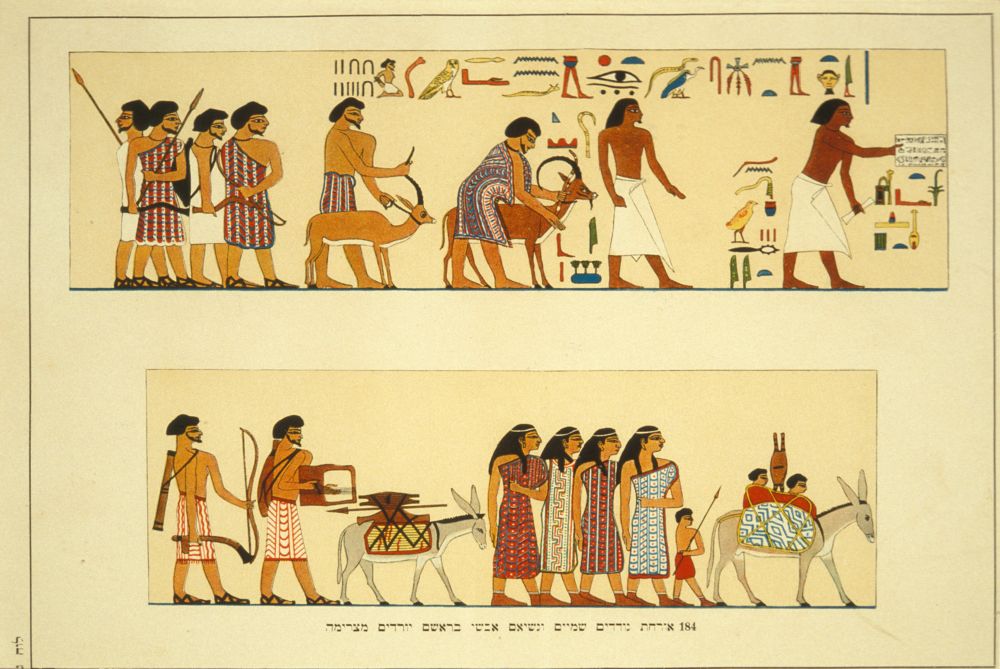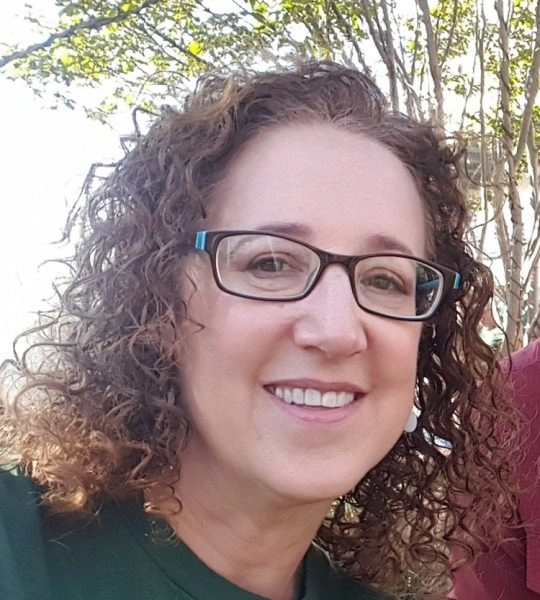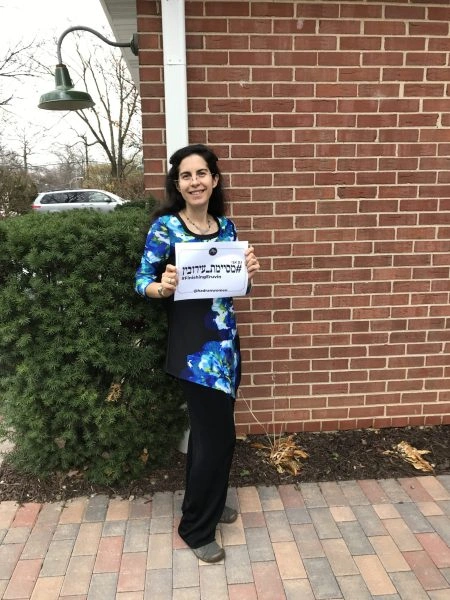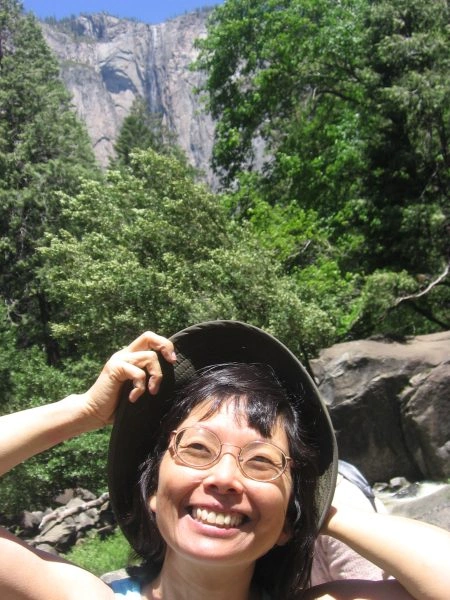Shabbat 27
מְנָא לֵיהּ? נָפְקָא מֵ״אוֹ בֶגֶד״. דְּתַנְיָא: ״בֶּגֶד״ — אֵין לִי אֶלָּא בֶּגֶד, שְׁלֹשָׁה עַל שְׁלֹשָׁה בִּשְׁאָר בְּגָדִים מִנַּיִין? תַּלְמוּד לוֹמַר: ״אוֹ בֶגֶד״.
from where does Rabbi Shimon ben Elazar derive that it can become ritually impure? The Gemara answers: In his opinion, it is derived from the verse that speaks of the ritual impurity of creeping animals: “Or a garment, or skin, or sack” (Leviticus 11:32). The additional “or” comes to include items that are not generally included in the definition of garment. As it was taught in a baraita: From the fact that it says garment, I have derived nothing other than a whole garment; however, a swatch that is three by three handbreadths in other garments, from where is it derived that it can become ritually impure? The verse states: Or a garment.
וְאַבָּיֵי, הַאי ״אוֹ בֶגֶד״ מַאי עָבֵיד לֵיהּ? מִיבְּעֵי לֵיהּ לְרַבּוֹת שָׁלֹשׁ עַל שָׁלֹשׁ בְּצֶמֶר וּפִשְׁתִּים דְּמִטַּמֵּא בִּשְׁרָצִים.
The Gemara asks: And Abaye, who says that everyone agrees that other garments do not become ritually impure at all, this phrase: Or a garment, what does he do with it and what does it come to add? The Gemara answers: He needs it to include a small swatch of fabric that is three by three fingerbreadths made of wool or linen. Despite its size, it can become ritually impure from contact with creeping animals.
וְרָבָא, גַּלִּי רַחֲמָנָא גַּבֵּי נְגָעִים, וְהוּא הַדִּין לִשְׁרָצִים.
And Rava holds that there is no need for the verse to discuss that matter explicitly, as the Torah revealed in the case of leprosy that it is considered to be a garment, and the same is true with regard to the ritual impurity of creeping animals.
וְאַבָּיֵי, אִיכָּא לְמִיפְרַךְ: מַה לִּנְגָעִים שֶׁכֵּן שְׁתִי וָעֵרֶב מִטַּמֵּא בָּהֶם.
And Abaye holds that one cannot derive the halakhot of creeping animals from the halakhot of leprosy, as there is room to refute that comparison in the following manner: What comparison is there to leprosy, which has more stringent halakhot of ritual impurity, as even the warp and woof threads alone can become ritually impure from it, which is not the case with regard to ritual impurity from creeping animals? Therefore, even small scraps can become ritually impure from leprosy.
וְאִידַּךְ: אִי סָלְקָא דַּעְתָּךְ נְגָעִים חֲמִירִי, לִכְתּוֹב רַחֲמָנָא גַּבֵּי שְׁרָצִים וְלֵיתוּ נְגָעִים מִינַּיְיהוּ.
The other amora, Rava, says: If it should enter your mind to say that leprosy is more stringent, then the Torah should have written the halakha with regard to creeping animals, and let leprosy be derived from them. Ultimately, the two halakhot are paralleled to one another in the Torah. It would have been simpler to explicitly write the laws of creeping animals and to derive leprosy from them. Since that is not the case, it is proof that the halakhot of creeping animals can be derived from leprosy.
וְאִידַּךְ: נְגָעִים מִשְּׁרָצִים לָא אָתוּ, דְּאִיכָּא לְמִיפְרַךְ: מַה לִּשְׁרָצִים שֶׁכֵּן מְטַמְּאִין בְּכַעֲדָשָׁה.
The other amora, Abaye, said that this contention is fundamentally unsound, as leprosy could not be derived from creeping animals because there is room to refute this idea and challenge: What is the comparison to the ritual impurity of creeping animals, which is more stringent than the ritual impurity of leprosy, as the creeping animal makes one ritually impure even in a case where it is a lentil-bulk, which is not true of other types of ritual impurity? Therefore, verses were necessary to teach about the ritual impurity of both creeping animals and leprosy.
אָמַר אַבָּיֵי: הַאי תַּנָּא דְּבֵי רַבִּי יִשְׁמָעֵאל מַפֵּיק מֵאִידָךְ תַּנָּא דְּבֵי רַבִּי יִשְׁמָעֵאל. דְּתָנֵי דְּבֵי רַבִּי יִשְׁמָעֵאל ״בֶּגֶד״ — אֵין לִי אֶלָּא בֶּגֶד צֶמֶר וּפִשְׁתִּים, מִנַּיִין לְרַבּוֹת צֶמֶר גְּמַלִּים וְצֶמֶר אַרְנָבִים, נוֹצָה שֶׁל עִזִּים וְהַשִּׁירִין וְהַכָּלָךְ וְהַסְּרִיקִין? — תַּלְמוּד לוֹמַר: ״אוֹ בֶגֶד״.
Abaye said: This statement of the tanna of the school of Rabbi Yishmael diverges from another statement of the tanna of the school of Rabbi Yishmael, as the tanna of the school of Rabbi Yishmael taught: From the fact that the verse says garment, I have derived nothing other than the halakha that a garment of wool or linen can become ritually impure. However, from where is it derived to include garments made of camels’ hair and rabbits’ wool, goats’ hair or the types of silk, the shirayin, the kalakh, and the serikin among the fabrics that can become ritually impure? The verse states: Or a garment. The word “or” serves as an amplification to include all types of fabric.
רָבָא אָמַר: כִּי לֵית לֵיהּ לְהַךְ תַּנָּא דְּבֵי רַבִּי יִשְׁמָעֵאל בִּשְׁאָר בְּגָדִים שָׁלֹשׁ עַל שָׁלֹשׁ, שְׁלֹשָׁה עַל שְׁלֹשָׁה אִית לֵיהּ.
Whereas Rava said: There is no need to say that there is a dispute in this case between two tanna’im from a single school. Rather, when this tanna from the school of Rabbi Yishmael, quoted above, is not of the opinion that there is ritual impurity in other garments, it is only with regard to a swatch that is three by three fingerbreadths; however, with regard to a cloth that is three by three handbreadths he is of the opinion that it becomes ritually impure. His previous statement came to exclude a small garment from becoming ritually impure. This statement is referring to a larger garment that is three by three handbreadths.
וְהָא רָבָא הוּא דְּאָמַר שְׁלֹשָׁה עַל שְׁלֹשָׁה בִּשְׁאָר בְּגָדִים, לְרַבִּי שִׁמְעוֹן בֶּן אֶלְעָזָר אִית לֵיהּ, לְתַנָּא דְּבֵי רַבִּי יִשְׁמָעֵאל לֵית לֵיהּ! הֲדַר בֵּיהּ רָבָא מֵהַהִיא. וְאִי בָּעֵית אֵימָא, הָא רַב פָּפָּא אַמְרַהּ.
The Gemara asks: Isn’t Rava the one who said above that, in the case of three by three handbreadths in other garments, Rabbi Shimon ben Elazar is of the opinion that they can become ritually impure, whereas the tanna of the school of Rabbi Yishmael is not of the opinion that they become ritually impure? The Gemara answers: Rava retracted that opinion in order to reconcile the opinions of the tanna’im of the school of Rabbi Yishmael. And if you wish, say instead a different answer: Rav Pappa said this statement and not Rava. Since Rav Pappa was the primary disciple of Rava, the Gemara attributed his statement to Rava.
רַב פָּפָּא אָמַר: אַף כֹּל, לְאֵתוּיֵי כִּלְאַיִם. כִּלְאַיִם בְּהֶדְיָא כְּתִיבִי בֵּיהּ: ״לֹא תִלְבַּשׁ שַׁעַטְנֵז צֶמֶר וּפִשְׁתִּים יַחְדָּיו״! סָלְקָא דַּעְתָּךְ אָמֵינָא, הָנֵי מִילֵּי דֶּרֶךְ לְבִישָׁה, אֲבָל בְּהַעֲלָאָה כֹּל תְּרֵי מִינֵי אָסוּר.
Rav Pappa himself understood the first statement of the tanna of the school of Rabbi Yishmael and stated it in a completely different manner. In his opinion, the derivation from the halakhot of leprosy, which concluded that even all nonspecific mentions of garments in the Torah refer to wool or linen, came to include the halakhot of diverse kinds, the Torah prohibition to wear clothing made from a mixture of wool and linen threads. He sought to prove that the halakhot of prohibited mixtures of threads apply only to wool and linen. The Gemara asks: Why does he require this derivation with regard to the prohibition of diverse kinds? The fact that the prohibition is limited to wool and linen is explicitly written, as it is stated: “You shall not wear diverse kinds, wool and linen together” (Deuteronomy 22:11). The Gemara answers: Nevertheless, an additional derivation was necessary, as it would have entered your mind to say that this, the restriction of the prohibition of diverse kinds to wool and linen, applies specifically to a case when one uses them together in the manner of wearing them; however, in merely placing the garments upon oneself, any two kinds are prohibited. Therefore, it was necessary to derive that the garment mentioned is restricted to wool and linen.
וְלָאו קַל וָחוֹמֶר הוּא? וּמָה לְבִישָׁה דְּקָא מִיתְהֲנֵי כּוּלֵּי גּוּפֵיהּ מִכִּלְאַיִם, אָמְרַתְּ צֶמֶר וּפִשְׁתִּים — אֵין, מִידֵּי אַחֲרִינָא לָא. הַעֲלָאָה לֹא כׇּל שֶׁכֵּן? אֶלָּא דְּרַב פָּפָּא בְּדוּתָא הִיא.
This claim is rejected: And is it not an a fortiori inference? Just as in the case of wearing the garment, where one’s entire body derives benefit from the diverse kinds, you said that wool and linen, yes, are included in the prohibition, other materials, no, are not included; in the case of merely placing the garment upon himself, all the more so that the halakha should not be more stringent. Rather, certainly the halakha that was attributed to Rav Pappa is a mistake, and he did not say it.
רַב נַחְמָן בַּר יִצְחָק אָמַר: אַף כֹּל
Rav Naḥman bar Yitzḥak also said that those statements of the tanna of the school of Rabbi Yishmael do not refer to the halakhot of ritual impurity. They refer to another topic. In his opinion, the tanna of the school of Rabbi Yishmael came to say that just as the halakhot of leprosy are limited to garments made from wool or linen, so too, all
לְאֵתוּיֵי צִיצִית. צִיצִית בְּהֶדְיָא כְּתִיב: ״לֹא תִלְבַּשׁ שַׁעַטְנֵז צֶמֶר וּפִשְׁתִּים״, וּכְתִיב: ״גְּדִילִים תַּעֲשֶׂה לָךְ״! סָלְקָא דַּעְתָּךְ אָמֵינָא כִּדְרָבָא. דְּרָבָא רָמֵי, כְּתִיב: ״הַכָּנָף״, מִין כָּנָף. וּכְתִיב: ״צֶמֶר וּפִשְׁתִּים יַחְדָּיו״, הָא כֵיצַד? צֶמֶר וּפִשְׁתִּים פּוֹטְרִין בֵּין בְּמִינָן, בֵּין שֶׁלֹּא בְּמִינָן. שְׁאָר מִינִין בְּמִינָן פּוֹטְרִין שֶׁלֹּא בְּמִינָן אֵין פּוֹטְרִין. סָלְקָא דַּעְתָּךְ כִּדְרָבָא קָא מַשְׁמַע לַן.
garments mentioned in the Torah are made from wool and linen. This comes to include the law of ritual fringes; the obligation of ritual fringes applies only to those materials. The Gemara asks: Why is that derivation necessary? With regard to ritual fringes it is written explicitly: “You shall not wear diverse kinds, wool and linen together” (Deuteronomy 22:11); and juxtaposed to it, it is written: “You shall make for you twisted fringes upon the four corners of your covering, with which you cover yourself” (Deuteronomy 22:12). From the juxtaposition of these two verses it is derived that the mitzva of ritual fringes applies only to garments to which the laws of diverse kinds apply. Rav Naḥman bar Yitzḥak responded that the matter is not so clear, as it could have entered your mind to say in accordance with the statement of Rava. As Rava raised a contradiction: On the one hand, it is written: “And that they put with the fringe of each corner a thread of sky blue” (Numbers 15:39); apparently, the threads of the ritual fringes must be of the same type of fabric as the corner of the garment. However, in Deuteronomy, in the laws of ritual fringes, it is written in juxtaposition to the laws of diverse kinds: Wool and linen together. The ritual fringes may only be made of those materials. How can that contradiction be resolved? Rather, Rava says: Ritual fringes made of wool and linen exempt the garment and fulfill the obligation of ritual fringes whether the garment is of their own type, wool or linen, whether it is not of their own type. Whereas with regard to other types, a garment of their own type, they exempt; a garment not of their own type, they do not exempt. It would have entered your mind to explain this in accordance with the approach of Rava. Therefore, the tanna taught us that the obligation of ritual fringes applies only to wool and linen and not to other materials.
אָמַר רַב אַחָא בְּרֵיהּ דְּרָבָא לְרַב אָשֵׁי: לְתַנָּא דְּבֵי רַבִּי יִשְׁמָעֵאל, מַאי שְׁנָא לְעִנְיַן טוּמְאָה דִּמְרַבֵּי שְׁאָר בְּגָדִים, דִּכְתִיב — ״אוֹ בֶגֶד״, הָכָא נָמֵי לֵימָא לְרַבּוֹת שְׁאָר בְּגָדִים מֵ״אֲשֶׁר תְּכַסֶּה בָּהּ״? הַהוּא — לְאֵתוּיֵי כְּסוּת סוֹמֵא הוּא דַּאֲתָא. דְּתַנְיָא: ״וּרְאִיתֶם אוֹתוֹ״ — פְּרָט לִכְסוּת לַיְלָה. אַתָּה אוֹמֵר פְּרָט לִכְסוּת לַיְלָה, אוֹ אֵינוֹ אֶלָּא פְּרָט לִכְסוּת סוֹמֵא? כְּשֶׁהוּא אוֹמֵר ״אֲשֶׁר תְּכַסֶּה בָּהּ״, הֲרֵי כְּסוּת סוֹמֵא אָמוּר. הָא מָה אֲנִי מְקַיֵּים ״וּרְאִיתֶם אוֹתוֹ״ — פְּרָט לִכְסוּת לַיְלָה.
Rav Aḥa, son of Rava, said to Rav Ashi: According to the tanna of the school of Rabbi Yishmael, what is different about ritual impurity that he includes other garments not made of wool and linen because it is written: Or a garment, which is a term of amplification? Here too, in the matter of ritual fringes, say that it comes to include other garments from the phrase: Of your covering, with which you cover yourself. Rav Ashi answered: That amplification is necessary to include the garment of a blind person in the obligation of ritual fringes. As it was taught in a baraita, with regard to ritual fringes it is stated: “And it shall be unto you for a fringe, that you may look upon it and remember all the mitzvot of the Lord” (Numbers 15:39). The phrase: That you may look, comes to exclude a night garment, which cannot be seen and is therefore exempt from the mitzva of ritual fringes. The tanna continues: Do you say that the verse comes to exclude a night garment? Or is it only to exclude the garment of a blind person who is also unable to fulfill the verse: That you may look upon it? The tanna explains: When it says in Deuteronomy: Of your covering, with which you cover yourself, the garment of a blind person is mentioned, as he too covers himself with a covering. If so, then how do I fulfill the exclusion: That you may look upon it? It comes to exclude a night garment.
וּמָה רָאִיתָ לְרַבּוֹת סוֹמֵא וּלְהוֹצִיא כְּסוּת לַיְלָה? מְרַבֶּה אֲנִי כְּסוּת סוֹמֵא שֶׁיֶּשְׁנָהּ בִּרְאִיָּיה אֵצֶל אֲחֵרִים, וּמוֹצִיא אֲנִי כְּסוּת לַיְלָה שֶׁאֵינָהּ בִּרְאִיָּיה אֵצֶל אֲחֵרִים.
The Gemara asks: Since there is one verse that includes and another verse that excludes, what did you see that led you to include a blind person and to exclude a night garment in the obligation of ritual fringes? The Gemara answers: I include the garment of a blind person because it is, at least, visible to others, and I exclude a night garment because it is not even visible to others.
וְאֵימָא לְרַבּוֹת שְׁאָר בְּגָדִים? מִסְתַּבְּרָא קָאֵי בְּצֶמֶר וּפִשְׁתִּים מְרַבֵּה צֶמֶר וּפִשְׁתִּים. קָאֵי בְּצֶמֶר וּפִשְׁתִּים מְרַבֵּה שְׁאָר בְּגָדִים?!
The Gemara asks: And say that this amplification does not come to include a blind person’s garments, but rather, as Rava said, to include other garments not made from wool or linen in the obligation of ritual fringes. The Gemara answers: It is logical to say that since the Torah is standing and discussing a garment made of wool or linen, it is certainly including another garment made of wool or linen. Therefore, an amplification with regard to the garment of a blind person made of wool or linen is derived. However, when the Torah is standing and discussing a garment made from wool or linen, is it reasonable to say that it is including other garments with them? Rather, other garments are certainly not derived from there.
אָמַר אַבָּיֵי: רַבִּי שִׁמְעוֹן בֶּן אֶלְעָזָר וְסוֹמְכוֹס אָמְרוּ דָּבָר אֶחָד. רַבִּי שִׁמְעוֹן בֶּן אֶלְעָזָר הָא דַּאֲמַרַן. סוֹמְכוֹס — דְּתַנְיָא: סוֹמְכוֹס אוֹמֵר סִיכְּכָהּ בִּטְוִוי פְּסוּלָה מִפְּנֵי שֶׁמִּטַּמְּאָה בִּנְגָעִים.
The Gemara returns to discuss the opinion of Rabbi Shimon ben Elazar, who disqualified even small cloths from being used as roofing in the sukka because they can become ritually impure. Abaye said: Rabbi Shimon ben Elazar and Sumakhos said the same thing. The Gemara specifies: Rabbi Shimon ben Elazar; that which we stated above. Sumakhos; as it was taught in a baraita: Sumakhos says: A sukka that he roofed with roofing made from spun thread is disqualified because spun thread can become ritually impure from leprosy.
כְּמַאן — כִּי הַאי תַּנָּא, דִּתְנַן: שְׁתִי וָעֵרֶב מִטַּמֵּא בִּנְגָעִים מִיָּד, דִּבְרֵי רַבִּי מֵאִיר. וְרַבִּי יְהוּדָה אוֹמֵר: הַשְּׁתִי מִשֶּׁיִּשָּׁלֶה, וְהָעֵרֶב מִיָּד, וְהָאוּנִּין שֶׁל פִּשְׁתָּן מִשֶּׁיִּתְלַבְּנוּ.
In accordance with whose opinion is Sumakhos’ statement? It is in accordance with the opinion of this tanna, as we learned in a mishna: Warp and woof can become ritually impure from leprosy immediately after they are spun; this is the statement of Rabbi Meir. Rabbi Yehuda says: The warp can become ritually impure only after it is removed from the cauldron in which it is boiled, and it is only the woof that can become ritually impure immediately. However, the bundles of unprocessed flax can become ritually impure after they are bleached in the oven and their processing is at least half-completed. Sumakhos, the student of Rabbi Meir, adheres to his position.
מַתְנִי׳ כׇּל הַיּוֹצֵא מִן הָעֵץ אֵין מַדְלִיקִין בּוֹ, אֶלָּא פִּשְׁתָּן. וְכׇל הַיּוֹצֵא מִן הָעֵץ אֵינוֹ מִטַּמֵּא טוּמְאַת אֹהָלִים, אֶלָּא פִּשְׁתָּן.
MISHNA: Of all substances that emerge from the tree, one may light only with flax on Shabbat (Tosafot) because the other substances do not burn well. And of all substances that emerge from the tree, the only substance that becomes ritually impure with impurity transmitted by tents over a corpse is flax. If there is a dead body inside a house or a tent that is made from any materials that originate from a tree, everything in the house becomes ritually impure. However, only in the case of flax does the tent itself become impure.
גְּמָ׳ מְנָלַן דְּפִשְׁתָּן אִיקְּרִי ״עֵץ״? אָמַר מָר זוּטְרָא: דְּאָמַר קְרָא ״וְהִיא הֶעֱלָתַם הַגָּגָה וַתִּטְמְנֵם בְּפִשְׁתֵּי הָעֵץ״.
GEMARA: The mishna mentioned flax as a material that comes from a tree. The Gemara asks: From where do we derive that flax is called a tree? Based on appearance, it does not resemble a tree at all. Mar Zutra said: It is derived from that which the verse said: “And she had taken them up to the roof and hidden them under the trees of flax” (Joshua 2:6).
וְהַיּוֹצֵא מִן הָעֵץ אֵינוֹ מִטַּמֵּא טוּמְאַת אֹהָלִים, אֶלָּא פִּשְׁתָּן. מְנָלַן? אָמַר רַבִּי אֶלְעָזָר: גָּמַר ״אֹהֶל״ ״אֹהֶל״
And we also learned in the mishna that with regard to any substance that emerges from the tree, the only substance that becomes ritually impure with impurity transmitted by tents over a corpse is flax. The Gemara asks: From where do we derive this? Rabbi Elazar said: The tanna learned a verbal analogy [gezera shava] between the word tent, written in the context of ritual impurity, and the word tent,
























